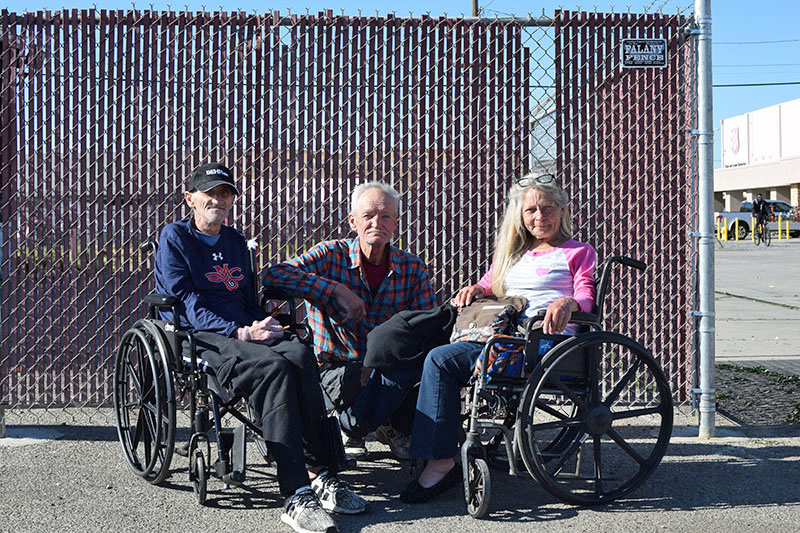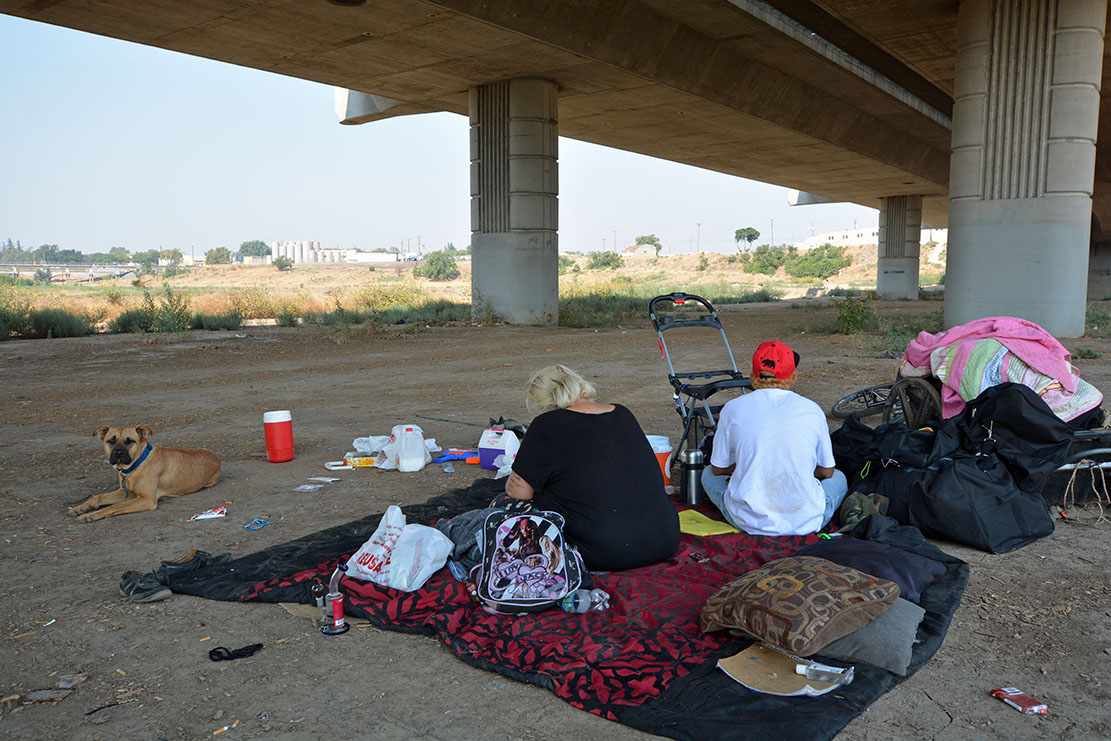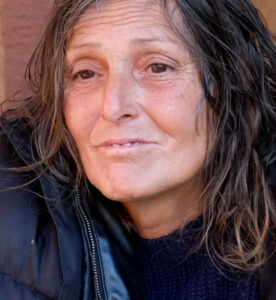For many of us, the cause of homelessness is simple: “It’s the drugs.”
Not far behind drugs as a cause of homelessness is the belief that, “They’d rather be homeless than work for a living.” This explanation goes back to Ronald Reagan’s declaration in 1982 that, “the people who are sleeping on the grates — the homeless who are homeless, you might say — by choice.”
Neither explanation is going to hold up when people displaced by the economic effects of Covid-19 begin flooding our streets and parks, an outpouring that has already begun and will get much worse as unemployment benefits and eviction moratoriums expire. For many people, relief efforts from state and federal governments will prove to be too little and too late.
Close observers of the homeless population in Modesto and other Valley cities are already seeing an influx of people new to the streets. They also realize that those presently living in their cars, a growing group that is seldom included in counts and surveys, will be on the streets when their cars break down, their insurance runs out, or when their vehicles are impounded for parking violations.
Once the Covid-caused economic disruption fills our streets with the newly homeless, Democrats will continue to blame Republicans and Republicans will continue to blame Democrats, but almost no one will be able to say, “It’s the drugs,” or, “They’re homeless by choice.”
And when people realize our newly homeless people are homeless because of circumstances beyond their control, they may start seeing long-term homelessness in different lights.

Consider, for example, the homeless people who are disabled. Their only income is from disability insurance. For most, payments are around a thousand dollars a month. These disabled homeless people are on the streets because they can’t afford to pay rent. Even in Modesto, where Bay Area workers flock because of “affordable” housing, average rents are $1340 a month and average apartment size is only 748 square feet.
Other homeless people are elderly and receive incomes from Social Security. Those incomes, even when combined by couples, often amount to a sum too small to afford food and shelter in a state where soaring housing costs continue to consume ever greater percentages of people’s budgets. In fact, over forty percent of California residents already spend more than thirty percent of their incomes on housing costs.
Then there are the homeless people who are mentally ill. Too disturbed to be taken care of by relatives and relegated to the streets by the systematic removal of social safety nets over the last four decades, reliable authorities estimate that twenty to twenty-five percent of homeless people are seriously mentally ill; forty-five percent have at some time been diagnosed as mentally ill to some degree.
Another rarely acknowledged factor in homelessness is brain damage associated with poverty. Robert Sapolsky, Stanford’s MacArthur “genius” award-winning Professor of Neurology and Neurological Sciences, has shown that poverty inhibits brain development in children. Thus, rising poverty levels over the last forty years are also a factor in homelessness; people with underdeveloped brains often struggle in school, work, and life.
Sapolsky has also documented the effects of stress on brain function; not surprisingly, stress has negative effects on decision-making. Long-term stress damages the brain irreparably. Few things are as stressful as homelessness.
Covid-19 is burning through the San Joaquin Valley like an inferno and will lead to even higher levels of homelessness and poverty in a region where homeless people already camp along the freeways, sleep in the parks and on the sidewalks, and pitch their tents along rivers and under bridges. Authorities have responded with attempts to place homeless people in shelters, hotels and remodeled motels, but the expenses have been astronomic.
In Modesto, repurposing a motel ran months behind schedule and cost upwards of $8,000,000 for 103 rooms, not counting management costs going forward. Efforts in New York and San Francisco to place homeless people in hotels have been met with protests about drug use, petty theft and sanitation issues.
Forward-thinking authorities have already realized that conventional approaches to an escalating crisis aren’t going to work. Even tiny houses and container conversions are prohibitively expensive and require lengthy lead times to become operative.
In Sonoma County, local leaders reacted to the homeless crisis by establishing an emergency community of over sixty tiny shelters in only ten days. The shelters, with a minimum size of sixty-four square feet, can be heated and air-conditioned. Toilets and showers are communal. At starting costs of $7,000, the units offer all the amenities of motel conversions at a tiny fraction of the costs, and can be ready almost immediately.
In 2019, Stanislaus County and the City of Modesto permitted homeless people to camp in a local park. Several months later, residents of what came to be known as “Beard Brook Village” moved to a nearby location under Modesto’s Ninth Street Bridge, to an encampment officially named the Modesto Outdoor Emergency Shelter (MOES).
As the MOES homeless population grew to over 400 residents, quality of life crimes dropped citywide. The concentration of people made it easier for volunteers and donors to offer time and resources, including food, clothing, and pet care. Costs worked out to about $13 per person per day.
MOES closed down when city and county authorities decided to transition people into extant shelters and a new low-barrier shelter in the Salvation Army’s Berberian Building on 9th Street in Modesto. However, the new shelter had only 182 beds, and extant shelters were full. No one seemed concerned about the shortfall of space as the majority of MOES residents were pushed back to the streets.

Today, after years of effort and expenditures of millions of dollars, there are as many homeless people in Modesto and throughout the Valley as ever, with more to come. Former residents of Beard Brook Village and MOES can be found scattered around Modesto, bedding down wherever they can as winter temperatures plunge toward freezing.
Meanwhile, cost-effective, humane, and timely responses to the rapidly escalating homeless crisis are readily available for those regions whose leaders have the political will to act decisively, and so is funding.


What other solution is more cost effective than a camp sanctioned for the homeless to live in?
MOES was a viable solution for those who were living on the streets. It provided stability and a place for the homeless community to call home. A stability that many residents hadn’t had for years.
I am.currently.homeless in Modesto and can t get help anywhere. I’ve been sleeping in my car that does not have a working heater. I had a place to live, but the woman I was living with moved to Chico and now I’m out on the streets. Everything I have is in my car basically.
My family and I are homeless and we have tried calling every resources I’m and get no help but sorry for your displacement I have called c.v.oc chs cvic housing authority habitat for humanity family promise the govener emailed the city and they all tell me to call the access center or 211 Wich tells me to call the mission Wich is now full .What no one seems to understand were homless because we can’t afford the high rent payments we don’t need a resource we need a program low income affordable rent section 8 not just another resource.The county got millions to house 🏡 the homless .We don’t even qualify for the homless program because I receive P UA . So don’t judge every homless person out here and say it’s due to drugs because I know alot of people wealthy people who do drugs and aren’t homless.
Shelly, send me an email at [email protected] with your contact info.
[email protected]
We are in the exact same situation… No help anywhere no matter who you Contact and just had our vehicle empounded despite it being our only shelter and will never afford to get it back… So put on the street because of late registration in the middle of a pandemic and I with an autoimmune disease in which stress lack of sleep is heat and cold and contracting covid could be a death sentence for me…. Still… No help thus far
The local political leadership, made mostly of Republicans, has shown little interest in the well being of those unfortunates who are homeless. Regardless of circumstance, they put the well being of their pets above that of fellow human beings.
If you examine public expenditures for homeless housing, you will notice a trend toward expenditures that benefit property owners, remodeling companies, and other businesses. Cost effective measures are overlooked. Just do the math for the cost per housing unit provided.
Giving vouchers for the homeless to rent units is always cheaper than buying and remodeling property.
So, the elected leaders throw money at the problem while enriching their friends and supporters. As always, follow the money.
Sorry to seem so cynical, but as time goes by, corruption becomes more the norm.
I never understood the logic of closing MOES. It seemed to be working. Why didn’t the city keep it and the Berberian Building as well? You can’t put ten pounds into a five pound container.
Well you can, BUT it kinda breaks the container.
We know how to break things but not fix them!
Interesting set of posts, especially the one that blames Republicans. Funny comment, since it is the Democrats who run this state, not republicans. Seems to me that a committee of people could come up with idea’s (included in this committee should include some of the homeless who can communicate with the group). This committee could bring forth some idea’s for alternatives to folks living on the street, then connect with the County or City Government to see about funding options.
Mr. Woods how do you think county and/or city would fund these recommendations?
Frank, may we be frank?
Are you really interested in answers to your query, or, do we detect smugness?